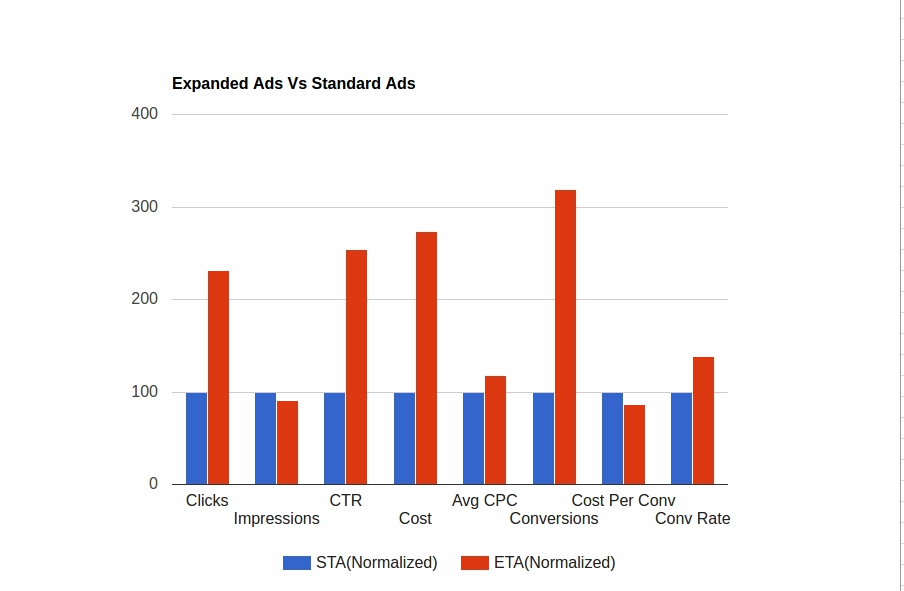It’s been almost 2 months since Expanded Text Ads (ETA) went live for all the Google AdWords advertisers. Early results for Expanded Text Ads were mixed.
From our experience, the impression share for ETAs went up slowly, over the weeks. Even now, the total impressions are less than half of all the impressions an account gets. If you have started building ETAs for your accounts immediately after Google’s account, right now, they are probably in a stable state. That is, ETAs are getting their allotted share of impressions. If you have set your ad rotation to optimize for conversions, Google has probably found a winning ETA.
Last week, Google extended the support for standard ads. Advertisers can now transition to ETAs till 31st January, 2017 (instead of 26th October, 2016, as announced earlier.) This gives advertisers another 3 months to fully migrate to ETAs.
I suspect, the impression share for ETAs in your account will continue to be throttled till 31st January. Till that time, you want to ensure that all of your ad groups have an ETA (or multiple of them) which is performing at least as good as your current standard ads. Though, standard ads will continue to be displayed alongside ETAs for some time, the competitive pressure will force you to move over to ETAs completely at some point in future.
That brings us to this AdWords Script, which will help you easily track performance of ETAs compared to standard ads. When you run this script, you will get one sheet with following processed data.
If you have used “Segment” feature in AdWords, this sheet is like having a “Segment by Standard Ads vs Expanded Ads” option at ad group level. For each ad group, you will see the cumulative performance of standard text ads and expanded text ads side by side. The columns are laid out to make it really easy for you to compare metrics (like CTR, Impressions, Conversions, etc.) for standard ads and expanded ads in an ad group.
The ad groups are sorted by total cost, in descending order. That is, performance of your highest spending ad groups will show up at the top. (Please note, STA – Standard Text Ads and ETA – Expanded Text Ads).

With this AdWords script, you will easily be able to do the following.
- Identify ad groups that do not have an active expanded text ad. These ad groups will be highlighted with red background for you already.
- Identify ad groups where ETAs are underperforming standard ads on any of the key metric, such as CTR, CPC, Conversion Rate, etc.
For example, if you want to highlight all the ad groups where CTR for expanded ads is less than CTR for standard ads, with a minimum 500 impressions for expanded ads, all you have to do is apply conditional formatting available in Google Sheets, where the results of this AdWords script are available.
The possibilities of the Expanded Text Ads script are limitless.
Then, there is a summary sheet, which visually tells you the account’s performance for expanded ads vis a vis standard ads. The key metrics for the account are summarized. Then, the metrics for standard ads are normalized to 100. Now, we find out where ETAs stand for each of the metric.
For example, here is a sample graph. The ETAs outperform standard ads significantly on all the important metrics. CTR for expanded ads is double that of standard ads. CPC is about 20% higher, but a 40% higher conversion rate means, the cost per conversion is lower than the standard ads.

How to get the Expanded Text Ads script?
If you are in a hurry, just grab this script, change the spreadsheet URL and run the script.
Here are the variables that you can change to customize it to your requirement.
- SPREADSHEET_URL : This is the only variable that you must change. This is the Google Sheet which will have the result once you execute the script. Create a new sheet with Google Sheet and copy-paste URL of that sheet in place of ‘https://docs.google.com/YOUR-SPREADSHEET-URL-HERE’.
- MAX_ADGROUPS : This report is generated for top ad groups in the account, by spend. This variable specifies number of top ad groups to be included in the report. By default, this is set to 500. That is, the report is generated for top 500 ad groups, by spend. You can increase this limit, if you are running a large account. From our experiments, we have see that it takes approximately one second to process one ad group. Increasing this limit will make the script run longer. A script can run for a maximum of 30 minutes, which means, about 2000 ad groups will be processed at a maximum.
- DATE_RANGE: You can use some predefined ranges like LAST_30_DAYS or LAST_14_DAYS, depending on the duration which you think best represents account’s data. For example, if you have launched bunch of new expanded ads 3 weeks ago, you can use data from last 7 or 14 days. By default, the script will get the data for last 14 days.
- IS_MCC_ACCOUNT : This flag is to indicate whether you will be running this script at MCC-level. By default, it is set to false. Change it to “true” if you want to use for all the linked accounts in your MCC account. The results for each account will be stored in two separate sheets – one with raw data and one has the summary. Be careful, if you have many many accounts.
- FILTER_ACCOUNTS_BY_LABEL : If your MCC account has tons of linked accounts, you may not want to run this script for all the accounts. In that case, turn this flag to “true” and then specify the label with ACCOUNT_LABEL_TO_SELECT variable. Only the accounts with the specified label will be analyzed to generate this report.
Take this script and see how your account is performing for expanded text ads.
Feel free to send an email (support AT karooya.com) if you have any queries for this script.
Get all the AdWords scripts published by Karooya
Related AdWords Scripts and Tools:






Eduardo
Thanks for the script
Great Idea. It’s very useful.
It would be good to include the option to exclude, retired or deleted ads, groups or campaings, and exlcude also the display ads, now it appears mixed in the report.
Shashikant
Hi Eduardo,
Thank you for the feedback. We will incorporate your feedback in the next version of the script.